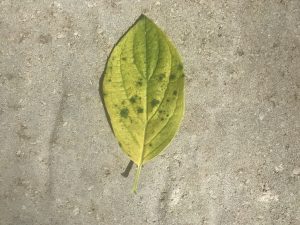Facts About Hydrangea Leaves Turning Yellow Uncovered
Facts About Hydrangea Leaves Turning Yellow Uncovered
Blog Article
Our Hydrangea Leaves Turning Yellow Diaries
Table of ContentsRumored Buzz on Hydrangea Leaves Turning YellowThe Of Hydrangea Leaves Turning YellowHydrangea Leaves Turning Yellow Things To Know Before You BuyGetting The Hydrangea Leaves Turning Yellow To WorkHydrangea Leaves Turning Yellow - An OverviewThe smart Trick of Hydrangea Leaves Turning Yellow That Nobody is Talking About
You can try to protect against fungal conditions by maintaining your gardens neat and devoid of particles. Offer your yards a good fall and spring clean up and eliminate all ground cover from the ground, in addition to from within the crown of the plant. These fallen leaves that will certainly stick around, waiting to strike in the following expanding season.Copper fungicides are, yet if they are overused they can end up being hazardous to your plant. Clip the leaves, and remove them from the yard.
If they aren't obtaining sufficient water, their leaves will brown. Hydrangeas have a in the lunchtime sunlight, and recovering once the sun has actually changed and the plants have a long time to recover. If this happens repetitively you might notice brownish and crispy leaves that are sagging. This is their means of allowing us know that it requires some extra moisture.

Rumored Buzz on Hydrangea Leaves Turning Yellow
If this is a reoccuring problem, you possibly need to reconsider your watering schedule. Established plants might need to be sprinkled one to 3 times per week, depending upon your problems. These hedges will certainly do best with one inch of water each week. It might appear tempting to spray the fallen leaves down.
Water the base of the plant,. As soon as the plant has recoiled, you can resume a normal watering schedule. A lot of species and ranges choose partial sunlight. Panicle hydrangeas love full sunlight, but the rest of the group really likes partial shade. Partial color provides regarding four to six hours of sunshine.
The container ought to be huge sufficient so the plant can expand and get all of the water and nutrients it needs. Panicles love the full sun.
So, despite the selection, strategy in advance and make sure your plant has a lot of security from the wind. You have a few options here. You might transplant to a new location, or you might produce a wind barrier utilizing one more plant, or fence. To develop a wind barrier you could, or a shrub to block the wind.
More About Hydrangea Leaves Turning Yellow
Ornamental grass, Rose of Sharon, or Holly shrubs are just a few concepts of plants you might use to obstruct the wind. If you need to hair transplant, discover a spot in your yard that is well secured from sun and wind. Hair transplanting is best done in the loss or the spring.
Every one of the above circumstances could take place to any kind of garden enthusiast. Thankfully for all of us, hydrangeas are really durable, and will certainly probably recover very rapidly with a little love and care. The plants area is the most vital element when it comes to obtaining recognized and correct development. With a little forethought on growing location and correct maintenance, you'll have the ability to guarantee your hydrangeas!.
So, if Hydrangea leaves turn yellow and diminishes later on, it's generally as a result of overwatering, as the plant can not uptake water and drops the fallen leaves to remove transpiration. Following this, Hydrangea leaves begin to sag and shrivel. Because both problems can create yellow leaves, you ought to identify the difference in between the overwatered and underwatered plant.
You can rescue the plant from yellow fallen leaves by providing it the proper light and placement. If your plant gets yellow leaves, relocate to a dark place. click this link Location Hydrangea plants inside near an east-facing home window. Dapple the plant with drapes or UV protection sheets to block direct warm.
The 5-Minute Rule for Hydrangea Leaves Turning Yellow
, and temperature level changes can trigger yellowing leaves and brownish areas. If it obtains as well warm, the sides of the fallen leaves become yellow, turn brown and develop a crunchy structure.
Heavy dirt can easily obstruct the oxygen supply to the roots and sever the connection with the top parts of the plant (fallen leaves). Hydrangea leaves transform their color if they discover small troubles in the Bonuses soil structure. This issue can create the Hydrangea delegates transform yellow, suffer from fallen leave drops, and provide a droopy plant compatible overwatering.
Yellow leaves in Hydrangeas are the initial signs of illness infestation, often complied with by black places, browning, drops, and wilting. Isolate the infected or pest-infested plant from the healthy plants to avoid condition spread. If it is a garden plant, eliminate all the contaminated fallen leaves using sterilized devices and cleanse up all the debris.
Reducing off helps Hydrangea color unneeded weight and coverage, permitting the growth of brand-new fallen leaves. The finest time to trim Hydrangeas is spring when the plant prepares to sprout vegetation for the following period. Evaluate for spent or diseased leaves and cut the base of a stalk that signs up with the fallen leaves and stem.
The 5-Minute Rule for Hydrangea Leaves Turning Yellow
Prevent reducing healthy or green leaves, and do not get rid of more than 25% of the plant's foliage. The major reason behind the red leaves in Hydrangea is inadequate soil or environmental problems.
Repot the plant each year in spring or every 2 years if the growth price is sluggish (Hydrangea Leaves Turning Yellow).
There are six major reasons this might take place:: The plant does not obtain enough sunlight.: The origins are either as well wet or also dry.: The plant is too cold.: The dirt is not acidic or alkaline enough for the hydrangea.: The plant isn't obtaining the best nutrients it requires to stay healthy and balanced.
Each factor affects the plant in a manner that can be repaired if we recognize exactly how to look after hydrangeas the ideal way. When we speak about inadequate light for hydrangeas, we indicate that the plant isn't obtaining sufficient sunshine. Hydrangeas choose bright light, however not straight, scorching sun. They commonly prosper finest with early morning sun and mid-day color.
Not known Incorrect Statements About Hydrangea Leaves Turning Yellow
Without sufficient sunshine, the fallen leaves can transform yellow, the plant can become weak, and it may create fewer flowers. To guarantee a hydrangea gets appropriate light, it needs to be positioned in a place where it can enjoy the morning light and be protected from the extreme mid-day sunlight. Hydrangea Leaves Turning Yellow. Overwatering is when a hydrangea plant obtains even more water than it needs

This problem is common in the loss as the weather changes or if a hydrangea is planted in a spot where it does not obtain adequate warmth from the sun. It is essential to understand the ideal conditions for hydrangeas to prevent low-temperature tension. For instance, most hydrangeas expand best in zones 6 to 9, where the environment is milder.
Report this page